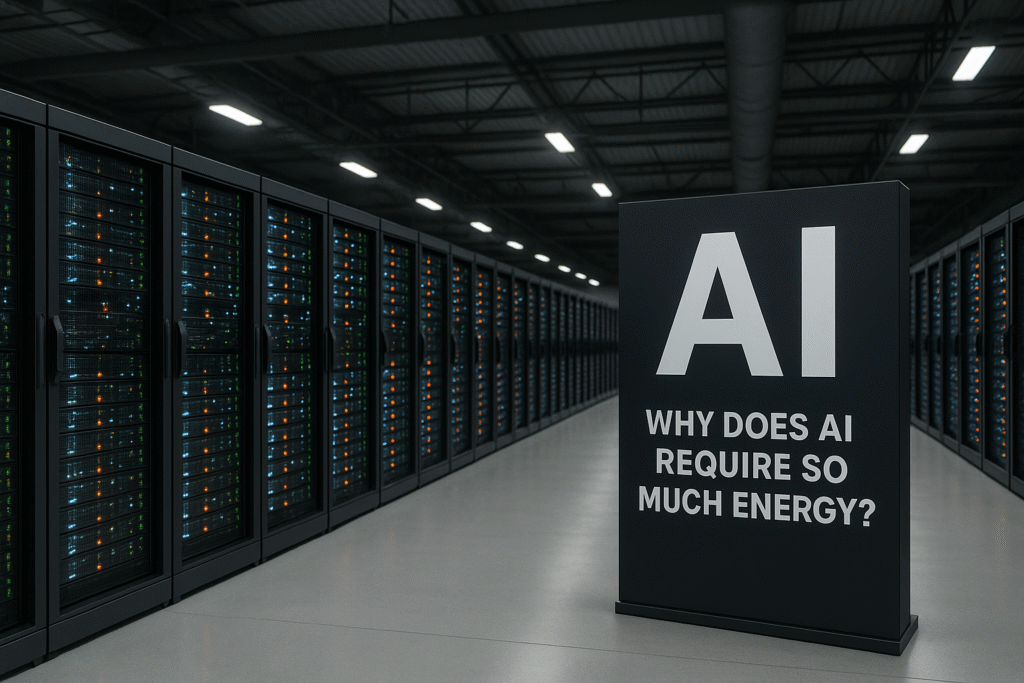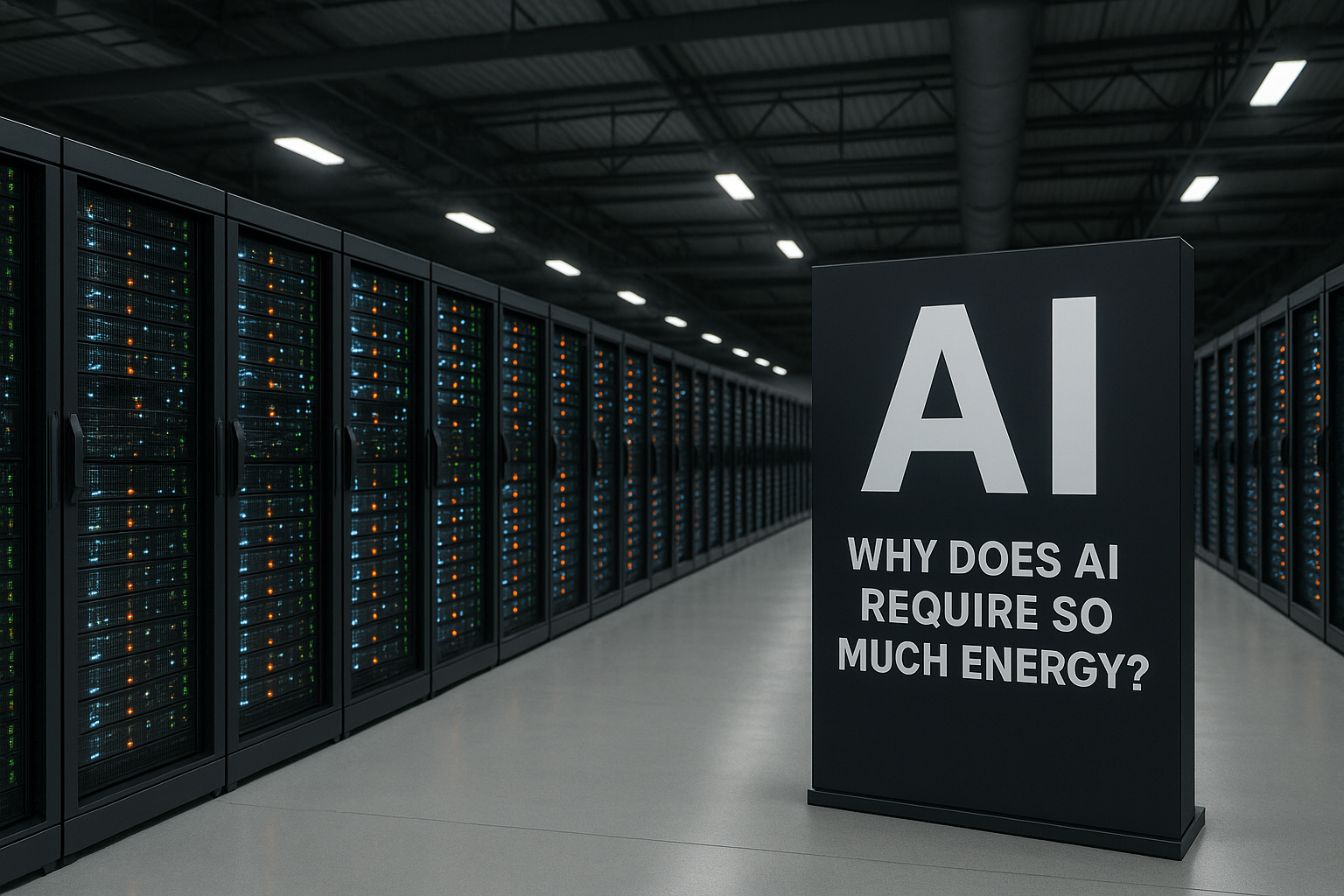Artificial intelligence is transforming industries, powering applications from natural language processing to autonomous vehicles. Yet behind the promise lies an uncomfortable truth: AI is hungry – not just for data, but for vast amounts of energy. As AI adoption accelerates, so do concerns about its environmental footprint, grid impact, and long-term sustainability.
This article explores why does AI require so much energy, breaking down the factors driving its consumption, the implications for the environment and infrastructure, and the strategies that can help balance innovation with responsibility.
1. Why AI Energy Use Is Surging
1.1 The Compute-Intensive Nature of AI
Modern AI, particularly deep learning and large language models (LLMs), requires immense computational power. Training a model like GPT-3 involves processing billions of parameters over weeks, using thousands of GPUs running in parallel (OpenAI Blog). This training process is computationally heavy because:
- Massive datasets: AI models are trained on terabytes of text, images, or video.
- Multiple training runs: Fine-tuning and experimentation require retraining models repeatedly.
- Parallel processing: High-performance GPUs and TPUs operate continuously at peak load.
The International Energy Agency (IEA) reports that AI workloads in data centers are growing at ~30% per year, compared to ~12% for overall data center growth. This growth directly relates to the question of why does AI require so much energy, as every stage in this process demands electricity and cooling.
1.2 Training vs. Inference Energy Costs
AI’s energy consumption is split between:
- Training: A one-time but resource-heavy process that can consume megawatt-hours of electricity.
- Inference: Running the trained model for millions of user queries daily, which adds up quickly at scale.
While training grabs headlines for its huge spikes in energy use, inference now represents the majority of AI’s total footprint, especially for consumer-facing models. Both contribute to the ongoing discussion of why does AI require so much energy.
1.3 Specialized Hardware Requirements
AI relies on GPUs, TPUs, and custom accelerators, which are less energy-efficient per watt than CPUs for general workloads. High-density racks require additional cooling, increasing indirect energy use and adding to why does AI require so much energy as a pressing concern.
2. Data Centers: The Power Behind AI
2.1 Scale of AI Data Center Growth
The IEA estimates global data center electricity use at ~415 TWh in 2024, with AI-related workloads already accounting for about 20% of that total. Goldman Sachs projects a 165% increase in total demand by 2030 (Goldman Sachs Report). Such numbers illustrate why does AI require so much energy on a global scale.
AI data centers are concentrated in regions like Northern Virginia, Dublin, and Singapore, where they can connect to high-capacity grids. However, their rapid growth strains local infrastructure.
2.2 Cooling and Water Use
Cooling systems account for a significant portion of data center energy demand. For AI workloads, cooling needs are greater because GPUs run hotter than CPUs. Many facilities use water-based cooling, which can consume millions of liters per day.
For example, training GPT-3 may have required around 700,000 liters of water for cooling (Nature). At scale, AI data centers could account for billions of cubic meters of water use annually – another angle in understanding why does AI require so much energy.
2.3 Power Density Challenges
AI-optimized data halls often run at 30-50 kW per rack, compared to 5-10 kW for typical enterprise servers. This high power density demands specialized electrical and cooling infrastructure, often leading to costly grid upgrades.
3. Environmental Implications
3.1 Carbon Footprint
Training GPT-3 emitted approximately 552 metric tons of CO2 – comparable to the annual emissions of over 100 passenger cars. While inference per query is smaller, the sheer number of queries compounds the impact and reinforces why does AI require so much energy as a climate concern.
Manufacturing AI hardware also adds to the footprint. Semiconductor fabrication is resource-intensive, requiring large amounts of water, rare earth elements, and energy.
3.2 Water Scarcity Concerns
AI’s water footprint is especially problematic in drought-prone regions. Data centers in Arizona, for instance, compete with residential and agricultural users for scarce water resources.
3.3 The Jevons Paradox in AI
Efficiency improvements, such as more efficient GPUs or model compression, can paradoxically increase total energy use because they lower costs and make AI more accessible, spurring greater demand.
4. Grid and Economic Impacts
4.1 Strain on Electrical Infrastructure
In the U.S., AI data center power demand could reach 4.4% of total national electricity consumption by 2030. In hotspot regions like Northern Virginia, utilities are already warning of delays in new connections.
4.2 Rising Energy Costs
High demand from AI can drive up wholesale electricity prices. In some areas, utilities are introducing data center-specific tariffs to ensure that residential customers are not subsidizing industrial-scale energy use.
4.3 Infrastructure Repurposing
Some countries are converting decommissioned coal or gas plants into AI data hubs, leveraging existing grid connections and cooling systems.
5. Strategies for Sustainable AI
5.1 Demand-Response Systems
Companies like Google are experimenting with shifting AI workloads to times of day when renewable energy is abundant, reducing peak grid load.
5.2 Green AI Design Principles
- Model optimization: Using pruning, quantization, and distillation to reduce computational requirements.
- Efficient architectures: Designing smaller models with competitive performance.
- Lifecycle analysis: Considering environmental impact from hardware manufacturing to decommissioning.
5.3 Renewable and Nuclear Integration
Pairing AI data centers with dedicated renewable generation or advanced nuclear projects can decouple growth from fossil fuel emissions. For example, Texas is developing a 1 GW nuclear-plus-solar complex to power AI workloads.
5.4 Policy and Regulation
Governments can incentivize energy-efficient AI through tax credits, renewable portfolio standards, and mandatory reporting of data center energy use.
6. A Deeper Look at Why AI Requires So Much Energy
This section addresses why does AI require so much energy from multiple angles:
- Algorithmic complexity: State-of-the-art AI models are designed with billions of parameters that require extensive computation.
- Global scale of deployment: Billions of daily interactions with AI systems multiply small per-query energy costs into significant totals.
- Infrastructure footprint: Beyond servers, AI’s ecosystem includes networking equipment, storage systems, and cooling facilities.
- Human and economic behavior: As AI becomes cheaper and more efficient, demand grows faster than efficiency gains can offset.
Understanding these elements helps every audience – from casual readers to policymakers – grasp the complete picture.
7. Perspectives from Different Audiences
7.1 General Tech-Interested Readers
For casual readers, the takeaway is that AI’s “invisible” operations have a tangible footprint. Every chatbot answer or image generation request requires real-world electricity.
7.2 Industry Professionals & AI Practitioners
Developers and engineers should prioritize efficiency in model design, deployment, and infrastructure planning. Energy use is both a cost and a reputational factor.
7.3 Policy Makers & Energy Stakeholders
Understanding AI’s growth trajectory is key for grid planning and regulatory frameworks. Proactive policies can balance economic benefits with environmental responsibility.
7.4 Environmental Researchers & Sustainability Advocates
AI offers tools for climate modeling and conservation, but its own footprint must be managed through transparent reporting and innovation.
Conclusion
AI’s energy demands are the result of computational intensity, specialized hardware, and global scale. The conversation about why does AI require so much energy connects technical realities with environmental and societal considerations. Left unchecked, these demands risk exacerbating climate change, straining water resources, and overloading electrical grids.
However, the same ingenuity that fuels AI’s growth can be harnessed to make it sustainable. Through innovation in model design, infrastructure, and energy sourcing, AI can evolve into a technology that is both powerful and responsible.
Call to Action: The discussion on why does AI require so much energy should involve technologists, policymakers, environmentalists, and the public. By recognizing the scope of the challenge and acting collaboratively, we can ensure AI’s future is not only intelligent but also sustainable.







